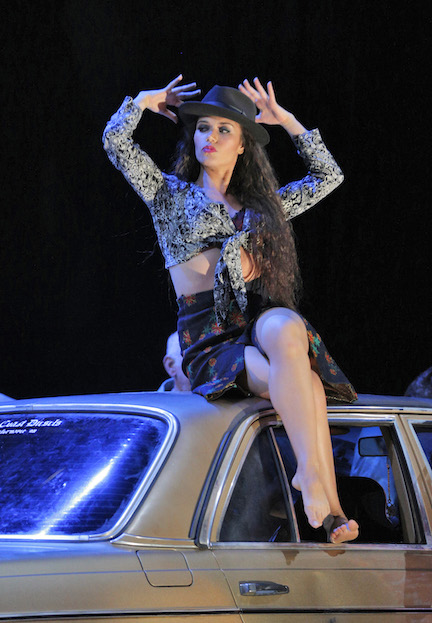
With its often frenzied rhythms, gripping dynamics, haunting minor key and exotic melodies, Carmen offers operatic moments that are undeniably musically compelling. That despite the fact that many of us grew up with cartoon versions of the Toreador procession and aria, often delighted by our own childhood renderings of these satires: “Toreador!/ Don’t spit on the floor!” Etc. Carmen’s first act La Habanera remains one of opera’s most popular and quotable arias.
Once the opera moves out of Looney Tunes and back to the opera house it faces a perplexing dilemma. How does one capture the spirit of the original? The daring portrayal of a sexually feral and amoral woman, captured by birth, and perhaps inclination, in the shadowy and marginal world of criminality and violence. That’s harder to do in our culture, immersed as it is in violence and overt sexuality, than perhaps it was in 1875 when Bizet’s opera opened at the Opéra Comique in Paris.
Today’s version at the War Memorial is a US premiere of a staging of the opera by Catalan director Calixto Bieito, which originally premiered in 1999. The current restoration was directed by Bieito’s longtime collaborator Joan Anton Rechi. It’s conducted by Carlo Montanaro, who does a snappy job keeping the opera symphony moving along from martial to tender in Bizet’s wonderful orchestration.
Bieito situated the opera, vaguely, in post-Franco Spain (Franco died in 1975, and the cars that are used flamboyantly throughout the production are from the 1980s), in Ceuta, an autonomous Spanish city located in North Africa.
As such the setting is allowed a bleak and almost frontier quality – wild, stark and cruel. There are few sets, merely the black hole of the unlit depths of the stage. In the first act the only sets are a flagpole and a telephone booth. People, instead, become the sets: lines of army guys, street urchins and women from the cigarette factory dressed in plain gray shifts. All choruses, the lines of singers stand and move in an almost regimental and confrontational manner to the fourth wall of the stage.
When Carmen appears she slips deftly out of her gray shift, revealing a more provocative black satin slip. She also first appears in the telephone booth, resulting in the first verse of “La Habanera” being sung more or less to the booth. An unfortunate placement for the left side of the audience.
Ginger Costa-Jackson sings some five performances of the opera. She’s a foxy physical choice with her long hair, narrow elven face and large eyes. Her voice is dark and sultry, seated comfortably in the lower register of the mezzo range, and she makes no attempt to beautify her voice or add sweetness. She often shouts out, or growls, words in the aria. Her Carmen is an angry young woman, manipulative and desperate.
Don José is sung by Brian Jagde (except for May 28, when the role was sung by Adam Diegel). Jagde has a lovely powerful tenor, but his big wholesome American presence keeps him from the desperation inherent in this role of sexual obsession. He’s lacking the neurasthenic edge of male vanity and desire that was so well captured by José Carreras during his prime. Jagde does manage a dark-circles-under-the-eyes desperation in the final scene, but his initial sexual captivity by Carmen doesn’t quite ring true. His “Flower Song” was pretty, but not heart-rending.
Erika Grimaldi gave a terrific presentation of Michaëla; her third act “Je dis que rien ne m’épouvante” was both tender and gripping. Bieito and Rechi’s portrayal of Michaëla stepped way far away from her usual portrayal as an innocent and sincere young woman. She even throws Carmen a spiteful and obscene gesture when Don José agrees to return to his village to see his dying mother. Really, guys?
Though there was much that was interesting about the direction and the concept of the direction, that interest and the possible freshness it might contain were often undermined by moments that just seemed gratuitous in their violence and sexual overtness. Like the beginning of Act 1 when a soldier in nothing but his Y-fronts and boots runs circles around the rest of the troops until he drops on his face in front of the audience. Or even worse, the end of Act 1, when the soldiers grab a woman, strip her down to bra and panties and run her up the flagpole. There were enough of these moments so that some irritated member of the audience shouted out, “Disgusting!” in the middle of Act 2.
My favorite audience moment was at the beginning of Act 3. Imagine the stage almost completely dark, in the far upstage a 20-foot-high black billboard in the shape of a bull stands out against a midnight blue background. Onto the stage steps a man who strips down not just to his underwear but to his well-muscled flesh. To the sweet sounds of harp and woodwinds, he moves his arm in low circular gestures, slowly and gracefully, as if he were drawing a matador’s cape across the body of a bull. Buck naked in the moonlight. (Rechi has an explanation for this: a “moon baptism” favored by superstitious matadors.) The dancer’s few gestures made, he picked up his clothes and walked off stage. Some wag in the audience shouted out, “Encore!”
– Jaime Robles
San Francisco Opera’s production of Bizet’s Carmen continues through July 3. For tickets and information, visit sfopera.com.
Photo: Ginger Costa-Jackson as Carmen. Photo courtesy Cory Weaver/ San Francisco Opera.
